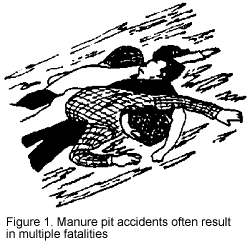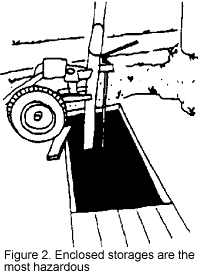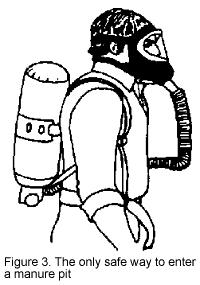 On-farm storage of animal manure each year is becoming more
common in Pennsylvania. Dairy, beef, swine, and veal enterprises
are all making increased use of manure storage systems as
a part of their operation. With each additional installation,
the probability that a fatal accident will result increases.
Tragically, experiences in several states indicate that when
an accident does occur, it is likely to involve two or three
fatalities (see Figure 1). Also, there have been several cases
of large numbers of livestock perishing due to manure gases.
On-farm storage of animal manure each year is becoming more
common in Pennsylvania. Dairy, beef, swine, and veal enterprises
are all making increased use of manure storage systems as
a part of their operation. With each additional installation,
the probability that a fatal accident will result increases.
Tragically, experiences in several states indicate that when
an accident does occur, it is likely to involve two or three
fatalities (see Figure 1). Also, there have been several cases
of large numbers of livestock perishing due to manure gases.
There are various types of manure storage systems, and some are more hazardous than others. Below ground storages, or pits, are more hazardous than above ground storages. Systems that are substantially covered by slotted floors, or have storage lids or caps, are more hazardous than those that have no type of top covering (see Figure 2). Thus, storages that are potentially the most dangerous utilize pits within buildings or directly beneath livestock. Pump-out pits with lids or caps can also be very hazardous.
Manure storage hazards include gases that are toxic (hydrogen sulfide), corrosive (ammonia), asphyxiant (carbon dioxide), and explosive (methane). Drowning is also possible. All of these hazards exist with covered pit type storages. Danger is most severe when manure is being agitated or pumped out, and after emptying if the pit is covered. At other times, gas production is very slight and ventilation from fans or natural air movement usually prevents hazardous buildup of the gases. Because open storages and above ground tanks are not covered, oxygen depletion and toxic and explosive gas buildup is less likely to occur. Therefore, the only potential hazard normally associated with these systems is drowning.
 Hydrogen sulfide is the most hazardous manure gas. It is colorless,
heavier than air, and can cause death within seconds at high
concentration. Hydrogen sulfide is identified by a rotten
egg odor and can be detected at low levels. However, the sense
of smell is deadened from concentrations much less than that
which is lethal. Additionally, the smell is often masked by
many other smells common to livestock facilities. The amount
of the gas can be increased a thousand-fold during agitation
nd emptying. Hydrogen sulfide is associated with most of the
fatalities from manure storages, both human and animal.
Hydrogen sulfide is the most hazardous manure gas. It is colorless,
heavier than air, and can cause death within seconds at high
concentration. Hydrogen sulfide is identified by a rotten
egg odor and can be detected at low levels. However, the sense
of smell is deadened from concentrations much less than that
which is lethal. Additionally, the smell is often masked by
many other smells common to livestock facilities. The amount
of the gas can be increased a thousand-fold during agitation
nd emptying. Hydrogen sulfide is associated with most of the
fatalities from manure storages, both human and animal.
Carbon dioxide is a non-toxic gas, but it does replace oxygen and, therefore, can asphyxiate humans and animals. Because it is colorless and odorless, carbon dioxide is impossible to detect without gas detection equipment. Since it is heavier than air, it usually accumulates near the bottom of the storage. Carbon dioxide does not usually build up to the point that it becomes lethal unless all ventilation into and around the pit has been eliminated for a few hours.
Ammonia can cause severe damage to the eyes, throat, and lungs. This gas combines with moisture in the eyes and respiratory tract to form an alkaline base, which results in severe burns. Ammonia is lighter than air and has a strong bleach-like smell. Because of its irritating nature, people usually leave the area quickly. Therefore, it is not suspected to have caused any human deaths. However, constant low-level exposure to ammonia can have a discomforting effect on humans and livestock.
Methane is a highly flammable and explosive gas. It, too, is odorless and colorless, and impossible to detect without gas detection instruments. Methane is lighter than air and readily rises out of storage areas. It can collect under hoods, roof ridges, and corners. It's most likely to accumulate during hot weather if ventilation is poor. There have been a few methane explosions resulting from lighting torches and sparks from a shorted electrical wire.
 There are several things an operator can do to minimize hazards
associated with stored manure. However, none is more important
than keeping people and animals out of buildings and providing
strong, constant ventilation during agitation and emptying.
Continue to ventilate for a few hours after pumping has stopped.
Ventilation systems should be equipped with alarms to warn
of failure, and auxiliary ventilation should be available
in case of power failure. Another recommendation is not to
fill your storage to capacity. Allow one to two feet of air
space to accommodate concentrations of gases. Also, always
keep the agitator below the liquid surface; use gas traps
in pipelines emptying into storages to keep gas from flowing
back into buildings; and forbid smoking, open flames, or spark
producing operations in the immediate vicinity of the storage
area.
There are several things an operator can do to minimize hazards
associated with stored manure. However, none is more important
than keeping people and animals out of buildings and providing
strong, constant ventilation during agitation and emptying.
Continue to ventilate for a few hours after pumping has stopped.
Ventilation systems should be equipped with alarms to warn
of failure, and auxiliary ventilation should be available
in case of power failure. Another recommendation is not to
fill your storage to capacity. Allow one to two feet of air
space to accommodate concentrations of gases. Also, always
keep the agitator below the liquid surface; use gas traps
in pipelines emptying into storages to keep gas from flowing
back into buildings; and forbid smoking, open flames, or spark
producing operations in the immediate vicinity of the storage
area.
Rescuing a person from a pit is a no win operation. Unfortunately, when someone collapses in a pit, gases are so high that it is literally suicide for anyone else to enter without a self-contained breathing apparatus (see Figure 3). The only reasonable action that can be taken is to provide ventilation into the storage and wait for rescue personnel with the proper equipment. Barn fans and silo blowers are sources of ventilation that may be used. However, do not lower fans into the pit because of possible methane gas buildup.
Uncovered storages at ground level should be fenced to keep people and animals off the crust-like surface that normally develops. The surface crust may harden in very dry or extended cold periods, but the hardening will be uneven. As the crust softens with changing weather conditions, a person or animal can suddenly break through. Do not leave ladders leaning against above ground tank storages. A person who accidentally falls into the tank will be trapped because he or she will be unable to limb the smooth surface.
Warning
signs should be placed near open storages and above ground
tanks, and a rescue pole and rope should be appropriately
located in the area. Remember to warn visitors and guests
of the hazards or manure storages because you are legally
responsible for their safety while on your property.
Publication #: 28
This document was published in 1991 as Pennsylvania State University Fact Sheet Safety, Pennsylvania Cooperative Extension Service. For more information, contact Pennsylvania State University College of Agricultural Sciences, Agricultural Engineering Department, 246 Agricultural Engineering Building, University Park, PA 16802.
Dennis J. Murphy, professor, Agricultural Engineering Department, Cooperative Extension Service, Pennsylvania State University, University Park, PA 16802.
Disclaimer and Reproduction Information: Information in NASD does not represent NIOSH policy. Information included in NASD appears by permission of the author and/or copyright holder. More